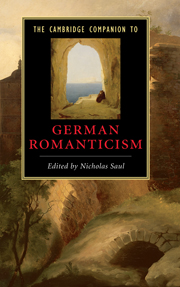Book contents
- Frontmatter
- 1 What is Romanticism, and where did it come from?
- 2 From early to late Romanticism
- 3 Prose fiction of the German Romantics
- 4 The Romantic lyric
- 5 The Romantic drama
- 6 Forms and objectives of Romantic criticism
- 7 Romanticism and Classicism
- 8 Women writers and Romanticism
- 9 The Romantics and other cultures
- 10 Love, death and Liebestod in German Romanticism
- 11 Romantic philosophy and religion
- 12 Romantic politics and society
- 13 Romantic science and psychology
- 14 German Romantic painters
- 15 Romanticism and music
- 16 Transformations of German Romanticism 1830-2000
- Key authors and their works
- Further reading
- Index
2 - From early to late Romanticism
Published online by Cambridge University Press: 28 September 2010
- Frontmatter
- 1 What is Romanticism, and where did it come from?
- 2 From early to late Romanticism
- 3 Prose fiction of the German Romantics
- 4 The Romantic lyric
- 5 The Romantic drama
- 6 Forms and objectives of Romantic criticism
- 7 Romanticism and Classicism
- 8 Women writers and Romanticism
- 9 The Romantics and other cultures
- 10 Love, death and Liebestod in German Romanticism
- 11 Romantic philosophy and religion
- 12 Romantic politics and society
- 13 Romantic science and psychology
- 14 German Romantic painters
- 15 Romanticism and music
- 16 Transformations of German Romanticism 1830-2000
- Key authors and their works
- Further reading
- Index
Summary
The Romantic epoch has, as is well known, been associated with diametrically opposed evaluations, with Romanticism being regarded as escapist or realist, reactionary or progressive in many variations. In addition to that, however, there are still unresolved debates as to whether Romanticism is an epochal movement with a single, clearly identifiable character, or falls into different phases which are more different from each other than from other literary movements. The conceptualisation of a clear split between early and late Romanticism was advanced most notably by Ricarda Huch, employing a botanical model, the organic sequence of blossoming and decay. Huch examines August Wilhelm and Friedrich Schlegel, Friedrich von Hardenberg (Novalis), Wilhelm Heinrich Wackenroder and Ludwig Tieck as exponents of early Romanticism. Its 'blossoming' consists, for Huch, in utopian thinking, namely the striving to balance reason and fantasy, mind and body, and developing the idea of human perfectibility, within an all-pervasive religious framework, as a task for everybody. Huch evaluates the early Romantics' interest in illness merely as a symptom of a necessary and transitory stage of development in their pursuit of unity and wholeness. However this model works more on a social and metaphoric than on a biological level. For while Friedrich Schlegel and, to a lesser extent, Ludwig Tieck could possibly be said to follow a route from blossoming to decay in their works, many of the late Romantic writers only began writing after the most prominent early Romantics (Wackenroder and Hardenberg) had died. Thus the 'decay' Huch laments in late Romanticism - renouncing the balance between mind and nature, giving up the spiritual side in favour of indulging in natural drives, leaning towards simplistic folklore and myth, demonstrating lack of receptivity and self-destructive tendencies - is the culturally mediated difference in approach of a new generation of writers.
- Type
- Chapter
- Information
- The Cambridge Companion to German Romanticism , pp. 21 - 40Publisher: Cambridge University PressPrint publication year: 2009
- 15
- Cited by

